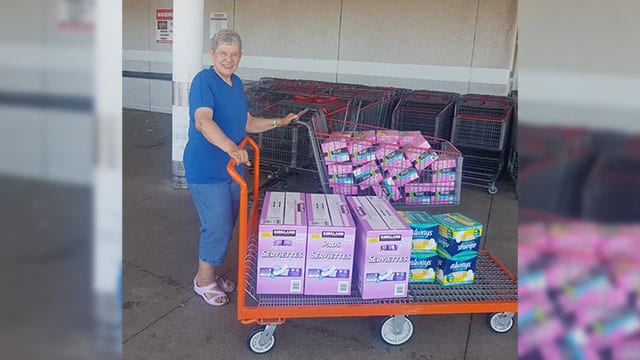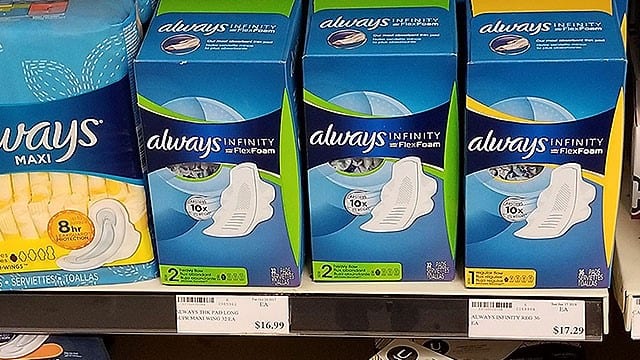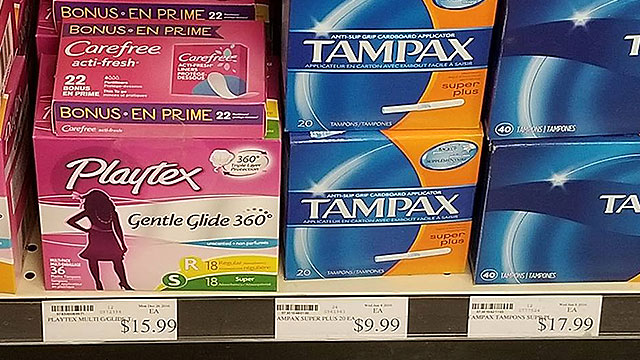
Vicki Briscall is shipping these feminine hygiene supplies to Iqaluit.
When Patty Krawec heard girls might be skipping school in Nunavut because of the high price of feminine hygiene products she put out a call for cash on social media.
The generous responses helped her load four hockey bags full of tampons, pads and related supplies to take along to the capital city of Iqaluit.
“I’m up about $1,500 now in two days,” she said on the phone while enroute to Ottawa airport.
“I’ve got 24 boxes of Playtex tampons, several boxes of Always (feminine pads), and some bladder-control products for elders.”
Krawec, who was flying north to visit her son, says donations came from strangers shocked to learn a box of tampons can cost $15 or more, maxi-pads $18 and ultra-thins $25.
“For some reason I had never connected food insecurity with sanitary product insecurity,” Krawec said of the sky-high prices Nunavummiut pay for shipped-in groceries.
“That to me just sounded so horrible. That these girls in Canada are missing school because these products are too expensive.”
Iqaluit Mayor Madeleine Redfern, who has tweeted about this big expense women face, says families in the north often forego basic needs because of the cost.
But she doesn’t think girls in Iqaluit are missing school because of it.
“Romeyn Stevenson, deputy mayor, is also the vice principal of the high school,” she said Monday. “He says they have such supplies available upon request.”
But Susan Fahidy thinks some girls are too embarrassed to ask for help.
“I’ve heard they’re going without or that they use socks,” said the director of Friends of the North, an Ontario group that sends donations to food banks on Baffin Island.

Price of menstrual pads in Iqaluit Northmart store.
Fahidy is glad to see a conversation about the “exorbitant cost” particularly in poverty-stricken communities.
“It’s a matter of do we eat or do we buy feminine hygiene supplies,” she said.
Redfern said the women’s shelter in Iqaluit is always in need of feminine hygiene products.
“There’s no free spending money and the shelter doesn’t get funding for such items,” she added.
Jeannie Bishop, director of YWCA Agvvik in Iqaluit, said for now their shelves are stocked but they do welcome donations.
Feminine hygiene products were subject to GST until 2015 but even without the tax, the cost is still a burden for many.
Bishop said they make sure women fleeing domestic violence don’t have to worry about buying monthly supplies.
However, she wouldn’t be surprised if girls miss classes due to their families’ inability to afford menstrual products. Especially in outlying communities.
She said no one she knows is co-ordinating such a service.
“I wouldn’t question for a second there are young girls who cannot go to school because their parents are not buying pads or Tampax,” she said.

Tampons for sale in the Iqaluit Northmart store..
“They get something like $359 a month (in social assistance)…There are crowded houses here. Average is 12 people per house in two-bedroom homes.”
Redfern noted the products are not included in the federal government’s Nutrition North food subsidy program.
Fahidy said her group responds to demand by holding about three drives for donations of feminine hygiene products annually.
“For these women to have to come forward requesting something like that can be quite embarrassing. And maybe a little bit intimidating,” she said.
“But I am hearing of it, that it’s being kind of whispered: ‘Can you get? Do you have any? Can you help?’”
She said a woman might be able to ask for assistance but she’s not sure how a teenager would handle the situation.
“It’s hard enough to deal with when you’re 14, let alone having to ask for help outside of your mother or grandmother,” Fahidy said.
Krawec, an Anishinaabe woman from Niagara Falls, Ont., posted photos of the bulging hockey bags on Facebook. Bags, she said, her church normally uses to ship school supplies and clothing to Nicaragua.
“I got a donation of $250 from someone I don’t even know. He messaged me on Twitter and said ‘I want to help.’ I’m like, dude, thank you very much.”
Krawec said her mom, Vicki Briscall, “kind of went wild” by using gift cards and rewards points to top up the shopping spree.
“It’s really exciting and sad,” she said of what she’s learning about northern expenses.
“Food insecurity in the north is the result of legislative policy decisions. It’s a systemic issue. This is a nice thing I can do. And I’m going there anyway.”
Krawec, who hosts a podcast about issues facing people of colour called Medicine for the Resistance, was planning to distribute her donations this week to the shelter, elementary school and high school.
She said she had been in touch with the mayor and was dismayed to learn government did not subsidize the prices.
“We shouldn’t have to fundraise for this in Canada,” Krawec said. “When we’ve got all this money for a pipeline.”










There is a possibility that those who are resistant to washable products have trouble accessing clean water. Many reserves STILL don’t have access to clean water. The Trudeau government failed miserably in its promises to make that happen. Also, between mining operations and nuclear waste storage, a LOT of natural water bodies near reserves have been poisoned. So even straight lake or river water can pose a risk. Under those circumstances, I could understand why someone wouldn’t want to go that route. It would be infinitely more difficult.
There has been a growing movement toward using washable reusable pads. They’re super easy to make and can be made from discarded, damaged clothes and towels. You don’t need access to a sewing machine – only scissors, thread and a needle. It would be a fantastic community building thing. Church groups, cultural groups, schools, retirement homes, everyone could pitch in an make them. Seniors or post-baby moms with small incontinence issues can also use them. Just trace the outline of your favorite pad or pantyliner. Cut it out to use as a pattern. Then use flannel, broadcloth scraps, or cotton jersey for the uppers. Use old towels in the center for absorbency. Then for a backing.. some arctic fleece. If you do a google search for washable menstrual pads, you’ll get LOTS of ideas. I prefer reclaimed materials though because it’s cheaper, and keeps it out of landfill.
There is a possibility that those who are resistant to washable products have trouble accessing clean water. Many reserves STILL don’t have access to clean water. The Trudeau government failed miserably in its promises to make that happen. Also, between mining operations and nuclear waste storage, a LOT of natural water bodies near reserves have been poisoned. So even straight lake or river water can pose a risk. Under those circumstances, I could understand why someone wouldn’t want to go that route. It would be infinitely more difficult.
There has been a growing movement toward using washable reusable pads. They’re super easy to make and can be made from discarded, damaged clothes and towels. You don’t need access to a sewing machine – only scissors, thread and a needle. It would be a fantastic community building thing. Church groups, cultural groups, schools, retirement homes, everyone could pitch in an make them. Seniors or post-baby moms with small incontinence issues can also use them. Just trace the outline of your favorite pad or pantyliner. Cut it out to use as a pattern. Then use flannel, broadcloth scraps, or cotton jersey for the uppers. Use old towels in the center for absorbency. Then for a backing.. some arctic fleece. If you do a google search for washable menstrual pads, you’ll get LOTS of ideas. I prefer reclaimed materials though because it’s cheaper, and keeps it out of landfill.
Diva cups and reusable pads are a good idea so long as they actually have running water. But that’s not guaranteed.
Diva cups and reusable pads are a good idea so long as they actually have running water. But that’s not guaranteed.
What I don’t get is most people here in Nunavut refuse to use reusable products.
1. Cloth diapers, for example. People complain about the price of “pampers” all the time. If you have 5 kids maybe consider washing your own diapers.
2. Tampons. Buy a diva cup. They cost like 30 bucks and last forever.
What I don’t get is most people here in Nunavut refuse to use reusable products.
1. Cloth diapers, for example. People complain about the price of “pampers” all the time. If you have 5 kids maybe consider washing your own diapers.
2. Tampons. Buy a diva cup. They cost like 30 bucks and last forever.
My very thought Courtney. This is a basic necessity for women and girls around the world and we need to help those communities in Canada where it is not easily accessible nor sustainable to use disposable feminine hygiene products.
My very thought Courtney. This is a basic necessity for women and girls around the world and we need to help those communities in Canada where it is not easily accessible nor sustainable to use disposable feminine hygiene products.
Yes, Courtney! I thought the same. Diva cups!
Could we fundraise to send up cloth pads or Reusable cups? They’re simple to use, and basic versions that are easy to hand wash are already made for other charities to bring to areas where water is scare (so being able to wash by hand is necessary). Cups are even more basic as a simple bottle of soap for it is all that’s needed to keep it clean. They’re good for 5+ years and a woman only needs one.
It would make far more sense than continuing to need disposable products every single month. It could give independence to these women, so they can live without fear of missing school or work if funding dries up. We could also help far more women that way.
Yes, Courtney! I thought the same. Diva cups!
Could we fundraise to send up cloth pads or Reusable cups? They’re simple to use, and basic versions that are easy to hand wash are already made for other charities to bring to areas where water is scare (so being able to wash by hand is necessary). Cups are even more basic as a simple bottle of soap for it is all that’s needed to keep it clean. They’re good for 5+ years and a woman only needs one.
It would make far more sense than continuing to need disposable products every single month. It could give independence to these women, so they can live without fear of missing school or work if funding dries up. We could also help far more women that way.